ETEC 511
Tiny Breathers
Group project for the assignment of Making a “Usable” Learning Tool.
Project Proposal:
Group Members: Zoe Armstrong, Victoria Teran, Fiona Mao, and Anh Lam
Background
Teaching is a high-stress profession, with increasing burnout rates among educators. Teacher burnout is a “psychological syndrome teachers experience in response to chronic job stress, including emotional exhaustion, depersonalization, and reduced personal accomplishment” (Xie et al., 2022). Recent data shows that nearly half of K-12 teachers in the United States experience burnout (Bouchrika, 2025). Technology has contributed to this stress, with constant connectivity, and increasing demands from parents, students, and administrators.
Teachers often struggle in isolation, with limited opportunities for reflection, leading to frustration and emotional depletion (Chang, 2009). Despite a growing focus on student mental health in educational technologies, practical solutions for teacher well-being remain scarce (Schimalla, 2023).
To address this, our group of educators and psychologists proposes Tiny Breathers, a micro-learning platform designed to provide educators with bite-sized mental health strategies, self-check-ins, and resources on topics such as classroom inclusivity and emotional resilience. Usability is central to its success, ensuring the tool is accessible, easy to navigate, and seamlessly integrated into educators’ daily routines. Research highlights usability as a key factor in mental health apps, influencing engagement, continuity, and positive impact (Alqahtani & Orji, 2019).
Building on Woolgar’s (1990) concept of user configuration, Tiny Breathers is tailored to teacher workflows, requiring low-effort engagement while maximizing support. Grounded in Nielsen’s Usability Heuristics (1994), simplicity, efficiency, and accessibility, it offers a practical, evidence-based solution to enhance teacher well-being, retention, and overall effectiveness.
We are planning to prototype Tiny Breathers using either Figma or Articulate Storyline to build out the common screens and 2 to 3 of the possible support pages based on the user’s response to our three-question self-assessment check. This will showcase the anticipated UX/UI from the user’s perspective. This project is a collaborative effort, with each team member contributing to key aspects of design, usability, and content development. Anh will lead the templating of pages, graphic design, and Figma development, ensuring an intuitive and visually appealing interface. Fiona will focus on user journey mapping, feedback and survey design, and support page content, optimizing engagement and responsiveness. Victoria will work on templating, user journey design, and support content, aligning the platform with real educator needs. Zoe will bring real-world expertise in education and facilitation, contributing to support content, and ensuring the platform is grounded in authentic classroom experiences. Together, the team will integrate usability principles to create a practical, engaging, and educator-centered tool.
Target Audience
The target audience for Tiny Breathers is adult educators. From preschool to college, demands on educators have only been increasing, especially since the COVID-19 Pandemic. As educators, we have seen first-hand the increase in burnout and mental health struggles amongst our peers. Williams (2024) writes how educators “are experiencing high levels of stress, anxiety and work-related trauma in the classroom.” Educators act as models for their students. If they are not prioritizing their mental health, who are the students to look to for guidance with their own? Few careers have more influence over young people’s futures than those of educators.
When educators have the ability to regulate their emotions and maintain a more positive outlook on life, their students’ well-being is positively affected (Braun et al., 2020). Not only that but, “When teachers feel supported and equipped to handle the challenges of their profession, they’re more likely to stick around,” (Neurolaunch, 2024). After researching thoroughly, we have found that currently, there exist very few, if any, resources designed specifically for educators to support their own mental wellness. For these reasons, we have chosen to design our project to support adult educators in upskilling their mental health through bite-size wellness activities.
Usability Assessment and User Configuration
To assess the usability of our prototype designed in Figma, our team will complete the initial user testing focussed on the logic, performance, ease of use, and functionality. We will incorporate the usability criteria and specifications from Issa and Isaias (2015) as best as we can for this prototype. Users will also have an opportunity to provide feedback on our app for review and further improvements to meet our usability goals. Hypothetically, if this were to venture further, the usability assessment would be more in-depth, with participants within our target audience and consisting of mixed methods to collect both quantitative and qualitative data.
Typically people look for support when they are experiencing challenges and seek quick, flexible, bite-sized support. Our goal is for educators to open our Tiny Breathers app at these moments of need. The first configuration is users who primarily use apps on a mobile device. Another round of configuration is the daily self-assessment of their mental and emotional situation at the start of the app, specifically the negative situations. We configure the user once again with our curated set of resources, and activities based on their selection: time available, emotional state, and interpersonal challenge.
Educational Usability
Aside from mental health and wellness support for educators, Tiny Breathers also offers direct and tertiary learning opportunities. Educators can learn from – and share – the materials and resources curated by our team and presented on support pages based on the self-assessment questions about their availability, emotion, and situation. The materials and resources provided not only contribute to their personal journey in mental health and wellness, which foster a deeper understanding and self-awareness, but also serve as valuable artifacts they can bring into their classrooms. By doing so, educators can promote emotional resilience in their students, helping to create a supportive environment where emotional well-being and mental wellness is nurtured. These resources can empower educators to model healthy coping strategies and offer tangible tools that encourage students to develop their own emotional resilience.
Key Features
Tiny Breathers will provide users with the opportunity to complete daily mental health checks and activities that fits into their busy schedule. The goal is to provide users with bite-sized support that meets their immediate needs while also providing resources for their personal learning journey and mental wellness. Examples of bite-sized activities include but are not limited to exercises for breathing, mindfulness, and meditation; guided journal prompts; affirmations; a passage from a book; and focus and movement activities. It will also offer progress tracking and activities which will vary based on responses from the self-assessment upon starting the app, offering flexible options and modalities to accommodate learning preferences. In addition, there will be a community space where users can connect with each other for more interactive emotional and mental support and learning opportunities.
References
Alqahtani, Felwah & Orji, Rita. (2019). Usability Issues in Mental Health Applications. 343-348. DOI: 10.1145/3314183.3323676 https://www.researchgate.net/publication/333740636_Usability_Issues_in_Mental_Health_Applications
Braun, S., Schonert-Reichl, K., & Roeser, R. (2020). Effects of teachers’ emotion regulation, burnout, and life satisfaction on student well-being. Journal of Applied Developmental Psychology, 69. https://doi.org/10.1016/j.appdev.2020.101151
Chang, ML. An Appraisal Perspective of Teacher Burnout: Examining the Emotional Work of Teachers. Educ Psychol Rev 21, 193–218 (2009). https://doi.org/10.1007/s10648-009-9106-y
Issa, T., & Isaias, P. (2015). Usability and human computer interaction (HCI). In Sustainable Design (pp. 19-35). Springer.
Maslach C.(2003) Job burnout: New directions in research and intervention. Curr. Dir. Psychol. Sci.;12:189–192. doi: 10.1111/1467-8721.01258
NeuroLaunch. (2024, October 1). Therapy for teachers: essential mental health support in education. NeuroLaunch. Retrieved February 7, 2025, from https://neurolaunch.com/therapy-for-teachers/
Nielsen, J. (1994, April 24). 10 Usability Heuristics for User Interface Design. Nielsen Norman Group. Retrieved February 11, 2025, from https://www.nngroup.com/articles/ten-usability-heuristics/
Schimalla, A. (2023, September 15). Mental Health in K–12 Schools: How Tech Can Help. EdTech Technology Solutions That Drive Business. Retrieved February 11, 2025, from https://edtechmagazine.com/k12/article/2023/09/mental-health-k-12-schools-how-tech-can-help-perfcon
Summer S. Braun, Kimberly A. Schonert-Reichl, Robert W. Roeser. (2020) Effects of teachers’ emotion regulation, burnout, and life satisfaction on student well-being. Journal of Applied Developmental Psychology. Volume 69. 101151. ISSN 0193-3973, https://doi.org/10.1016/j.appdev.2020.101151
Williams, L. (2024, January 23). Why teachers need, deserve mental health support. University of North Dakota. Retrieved February 7, 2025 from https://blogs.und.edu/und-today/2024/01/und-in-the-conversation-why-teachers-need-deserve-mental-health-support/
Woolgar, S. (1990). Configuring the user: The case of usability trials. The Sociological Review, 38(1, Suppl.), S58-S99.
Xie, M., Huang, S., Ke, L., Wang, X., & Wang, Y. (2022). The Development of Teacher Burnout and the Effects of Resource Factors: A Latent Transition Perspective. International journal of environmental research and public health, 19(5), 2725. https://doi.org/10.3390/ijerph19052725
Learning Tool:
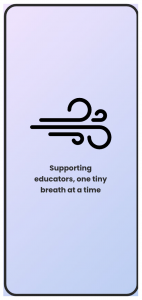
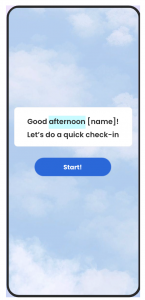
Tiny Breathers – an app designed to support the mental wellness of educators.
Project Demo & Presentation
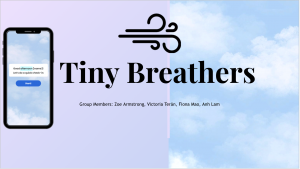
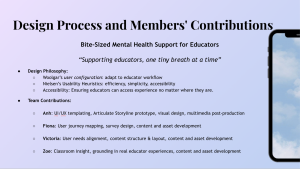
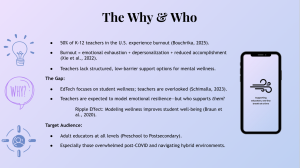
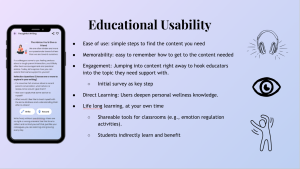
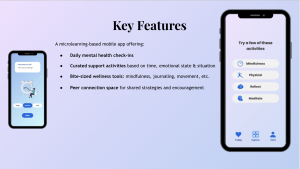
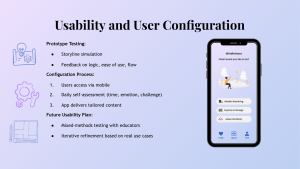
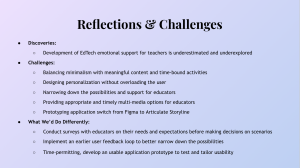
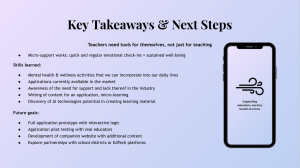
Retrospective
Tiny Breathers came from a place of burnout. Our team realized that there are very few resources designed specifically for the mental wellness of educators. Because of this, we wanted to create a user-friendly app that utilized bite-sized mental wellness techniques.
Our primary design focus was accessibility. It was of utmost importance that we created something that actually made sense for educators. As a middle school teacher, a large part of my role in this project was providing advice on whether educators would be on board with specific features. Giving the user options, through the three-question survey, allowed the app to tailor the content to their needs. Knowing educators are always short on time, the two, five, and 10-minute options were decided upon. The selection of content topics was also something I played a role in. Knowing the stressors of educators, I was able to help steer our group in the direction of the areas where support might be needed. Educators were our target users for this project, so we were able to assess the usability by gaining feedback from the educators in our group. This assessment was conducted using the “Usability Criteria” from Issa & Isaias (2015, p. 33). Lastly, having taken my Yoga Teacher Training and Social-Emotional Learning Facilitator training, I used this knowledge to assist with the content creation for this project.
Our team worked really well together, often meeting once a week to share our progress. We played to one another’s strengths, allowing the skills we each already possessed to guide our work in this project. One of our biggest challenges was narrowing down the content that we provided to users. It was challenging to not only stick to the time limit but also to provide content that felt purposeful. Woolgar (1990) discusses “boundaries” as part of how we configure users, and these boundaries we set out also helped to configure our app (p. 89). We know that educators can be harsh critics, thus, we prioritized ensuring they were provided with something that would meet their needs. In the future, surveying additional educators about the type of content delivered by the app would be beneficial. Utilizing an Artificial Intelligence (AI) to design additional content for the app would also be something to consider. “Artificial intelligence is now a player in the shaping of knowledge, communication, and power” (Crawford, 2021, p. 18). A cost analysis would need to be conducted, however, it could allow for an application like this to scale up.
Though time did not permit for this project, it would have been great for our team to be challenged in exploring a different aspect of the app creation. In the future, I would like to gain experience with designing in Articulate Storyline. As much as I was able to harvest my skills in content creation and my experience as a classroom teacher, I learnt several new skills. Being in constant communication with my group mates taught me how powerful it can be to have a team that works together. Designing bite-sized content taught me to be deliberate and intentional with my words when filming the videos. Understanding the systemic problem of teacher burn-out taught me to be even more critical of the items we add to our plates as teachers. The most rewarding part of this project was watching it go from a simple idea to a prototype that I could see my colleagues implementing into their practice one day.
References
Crawford, K. (2021). Atlas of AI. Yale University Press. (Introduction: pp. 1-21)
Issa, T., & Isaias, P. (2015) Usability and human computer interaction (HCI). In Sustainable Design (pp. 19-35). Springer.
Woolgar, S. (1990). Configuring the user: The case of usability trials. The Sociological Review, 38(1, Suppl.), S58-S99.
IP 5 – Digital Labour
References
Crawford, K. (2021). Atlas of AI. Yale University Press.
Duffy, B. E. (2017). (Not) getting paid to do what you love: Gender, social media, and aspirational work. Yale University Press.
Gandini, A. (2021). Digital labour: An empty signifier? Media, Culture and Society, 43(2), 369-380.
IP 4 – Sustainability
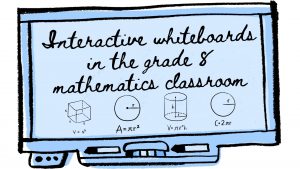
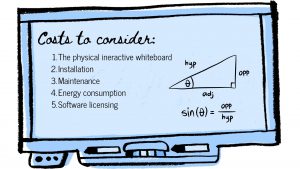

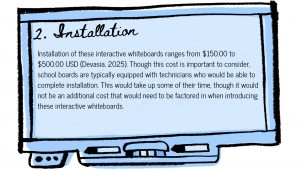
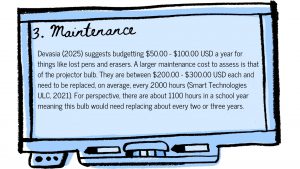
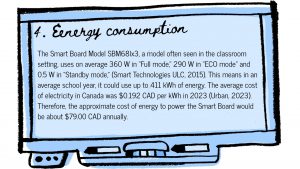
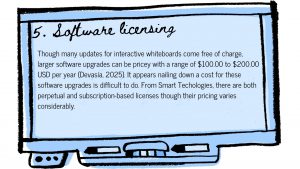
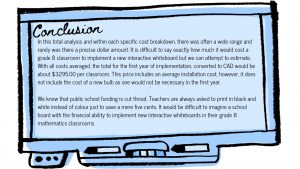
References
Devasia, A. (2025, March 17). Smart board cost & installation guide (2025). The Network Installers. Retrieved from: https://thenetworkinstallers.com/blog/how-much-is-a-smart-board/
Smart Technologies ULC. (2015). Specifications SMART board interactive whiteboard system model SBM685ix3. Retrieved from: https://downloads.smarttech.com/media/sitecore/en/support/product/smartboards-fpd/m600ix3/specs/specifications_sbm685ix3_01june15.pdf
Urban, R. (2023, September 3). Electricity prices in Canada 2023. Energy Hub. Retrieved from: https://www.energyhub.org/electricity-prices/
IP 3 – Global Health
Educational technology – is it ready to be foundational to education?
You don’t have to search very hard to find that the pandemic affected people differently. Many would tell you that the rich got richer and the poor got poorer. In relation to education, the learning gaps amongst students also got wider. The Canadian Commission for UNESCO (2021) shares, “it’s apparent that the children already most at risk are the ones likely to fall further behind.” And further behind they did fall. Not only that, but upon “returning” to the classroom in the Fall of 2020, the resources required to support these individual students in “catching up” were not in place. It is apparent, then, that a new foundation in education, built on the connectivity that educational technology provides, needs to be prioritized.
The education system was not prepared to transition from in-person to online learning overnight. Though educational technology had become a hot topic amongst educational stakeholders before the pandemic, as Boys (2021) discusses, it was still seen as an “add-on,” (p. 14). Face-to-face education was, and still often is, thought to be superior to whatever learning experience could be facilitated in an online environment. This rhetoric was only further justified by the pandemic with statements like “by September 2020, most US students would be “months behind” with some losing the equivalent of a full year’s worth of academic gains,” when referencing the learning loss that occurred in the online learning setting (Bennette, 2020). It was a difficult time for educators as their careers were being challenged and as they were told anyone could do their jobs. How interesting it would be, if parents and guardians took as much interest in their child’s in-person education as they were forced to take in their child’s online education during the pandemic.
Our education system still has a long way to go in terms of how and why educational technology needs to be prioritized. To further this claim, let us refer to the five Key Goals created by the COVID Education Alliance to support the “urgent need to transform education systems worldwide” (2020, p. 2).
1. “Build technical knowledge (e.g. new technologies, computational thinking, models, algorithms)” (COVID Education Alliance, 2020, p. 5)
For educational technology to be truly considered a foundation to our education system, the understanding of technology like algorithms, artificial intelligence (AI) and computational thinking needs to be more widely understood. For many, it still seems like “magic.” The current generation of students in our education system will never know a world without AI systems, such as ChatGPT. It is therefore essential that they understand these types of technologies and that they are meaningfully integrated into their learning. By gaining a stronger knowledge base of these technologies, the system will not only be better set up to support able-bodied learners, but also those often overlooked who may require additional supports and adjustments for their learning needs.
2. “Build character (e.g. define own goals and preferences for individual balance and well-being, build solid value system)” (COVID Education Alliance, p. 5)
Though we like to think that in times of darkness, we as a human race will come together for the betterment of our collective, the pandemic proved to divide us further apart. People’s opinions of how “things” should have been handled have been polarizing. Technologies in the classroom need to facilitate the idea of coming together while being apart. Bennette (2020) shared that only 12.6% of students felt connected to their friends and school through online learning during the pandemic. The connectivity that we so often praise technology for needs to be prioritized in our education system to better support students with the development of their character, something so desperately needed in times of global health emergencies.
3. “Build judgment (e.g. recognizing and countering deception, developing critical thinking for sound decision-making)” (COVID Education Alliance, p. 6)
With the emergence of new technologies comes an even more prominent need for critical thinking skills within the online realm. When we prioritize educational technology as a new foundation, educators and students need to be able to decipher between legitimate and illegitimate resources and tools. As mentioned, global health emergencies often result in the division of people. This can cause the spread of misinformation, especially in online settings. Our future generations need to develop the skills to use logical reasoning and objective thinking to help with the development of their personal opinions.
4. “Build resilience (e.g. to global challenges and their impacts, natural and human-made disruptions and shocks)” (COVID Education Alliance, p. 6)
An astounding 91.3% of students worldwide were affected by the shutdown of schools during the COVID- 19 pandemic (The Canadian Commission for UNESCO, 2020). If the education system is to prepare its students for anything and everything, these students need to be prepared for another displacement of the in-person classroom. Being able to adapt to a quickly changing environment, for example, online learning, is a skill that will continue to be useful as our world becomes more and more technological. The disruption of students’ regular school routine led to extensive mental health challenges during the pandemic. Bennette (2020) shares that “children were also reported to have been suffering persistent sadness and experiencing feelings of hopelessness,” while online learning. These are valid feelings. Students were thrown into a new environment they had no experience navigating. As a foundation, educational technology needs to become familiar to the point that students know it is a tool that will support them no matter what the world throws their way.
5. “Build social awareness and responsible citizenship (e.g. of contexts and environments, cultures, needs, and circumstances)” (COVID Education Alliance, p. 7)
Technology can allow us to see parts of the world we may never have been able to before. Building empathy for the way others experience the world is part of education. Educational technology as a foundation is already used to show students how others live. In 2020, Bennette shared that “the kids are not all right,” after having been online for months. Though educators did their best to try to replicate the camaraderie of the classroom in the online environment, students did not feel the same. The social aspect of the in-person classroom needs to be better reproduced online if educational technology is to truly become foundational to learning.
References
Bennette, P. W. (2020, July 20). The educational experience has been substandard for students during COVID-19. Policy Options.
Boys, J. (2021). Exploring inequalities in the social, spatial and material practices of teaching and learning in pandemic times. Postdigital Science and Education, 4(1), 13-32.
COVID Education Alliance (2020). COVID Education Alliance (COVIDEA): Adapting education systems to a fast changing and increasingly digital world through the use of appropriate technologies.
The Canadian Commission for UNESCO. (2020, April 20). COVID-19 Is creating a world crisis in education.
Tipping Point: A Critical Case Study
YouTube Takeover: The Displacement of the Beloved TV Cart
Introduction
There were two types of days that fired up an elementary school 90s kid. The first was a computer lab day. The sweet sound of 25 to 30 iMac 3Gs going off at the same time was a core memory for many. The second was walking into class to find your teacher had signed out the infamous TV cart. Whether it was a VHS or DVD player that the TV used, this machine was the holy grail of educational technology joy. Sadly (or not), these days are long gone and instead students are met with all the on-demand educational content they could ever imagine in the form of the infamous YouTube. When YouTube first came out in 2005, it had around two million video plays per day (Hosch, 2009). A month later? Over 25 million (Hosch, 2009). It is no wonder that the beloved TV cart was displaced by the endless learning vault that is YouTube. As Lake (2011) put it, “the days of wheeling in a VHS recorder and television to play a program to students have gone, replaced by a myriad of new audiovisual technologies,” (p. 72.1).
Context
As a current middle school teacher, I can’t imagine having to deal with the steps of getting a TV cart into my classroom. From signing it out, to ensuring I have access to the correct content to play, to running into problems while getting it set up in my room. I use YouTube every day in my practice and it has changed the way I approach questions in my classroom. When teaching Science specifically, students come to me all the time inquiring about topics we’ve discussed. Nine times out of 10, I do not have the answer. So, instead, I will either pull up a video for the class to check out, or I’ll encourage them to plug in their headphones and find the answer themselves so they can be the ones to share it with the class. This shift has allowed us to go far beyond what the curriculum is asking to be taught, and into the realm of student interest. This is the context I will be further studying the displacement of the TV cart with YouTube.
Catalyst
There were a number of factors that played a key role in how this displacement came to be. One of the most crucial elements was that internet speeds became high enough that streaming videos in the classroom was accepted. When Netflix first started their streaming service in 2007, very few folks had access to enough internet speed to allow a seamless watching experience (Christiansen, 2024). For a change to really impact the K-12 publicly funded education system, it has to be accessible and logically sound. “Teachers want ready access to fresh relevant programming that speaks to the curriculum,” (Lake, 2011). When wireless internet became the go-to sometime in the mid 2000s, it finally made more sense for videos to be streamed in classrooms than to wheel in the old TV cart (Zentro, n.d.). No longer did the entire period need to revolve around the viewing of a video. Now, videos could be integrated for only a portion of the period. Videos could be used to explain theories to students in different ways than the teacher could. Videos could be easily utilized to answer questions and seek more in-depth knowledge on topics students wanted to learn more about.
This pedagogical shift in allowing students to be the drivers of their learning was also an influence on the displacement of TV carts. Though the concept of student-centered learning has been around for over 100 years, it wasn’t until our present century that the shift in classroom instruction started to change (Kaput, 2018). Having YouTube in the K-12 classroom meant that students now had access to millions of videos that could be found to help students learn more about a specific content area of their choosing. Duffy (2007) discusses how “a great deal of the medium’s power lies not in itself but in how it is used,” (p. 124). At the time that YouTube became more prominent in the classroom, educators were looking for a tool that would increase student engagement by allowing students to explore more of their own interests. The “power” of YouTube allowed the classroom focus to shift from the teacher to the student.
Educational Usability
As a classroom tool, YouTube is wildly more concerned with educational usability than the TV cart ever was. Issa and Isaias (2015) quote Benyon et al. (2005) by sharing that usability “refers to the quality of the interaction in terms of parameters such as time taken to perform tasks, number of errors made, and the time to become a competent user,” (p. 52). When being mindful of a tool’s educational usability specifically, thought must also be given to its accessibility, its ability to engage, and its reliability. As educators became more concerned with centering their students in their learning, it became evident that the TV cart did not fare well in its usability.
Having TV carts replaced by YouTube, it is evident that the latter was “designed for the needs and capabilities of the people for whom they are intended,” (Issa & Isaias, 2015, p. 20). Because of the extremely wide range of content on YouTube, the ability to scaffold and diversify the content provided for students was limitless. Mishra (2025) shares how “YouTube’s accessibility settings promote inclusivity and ensure that everyone, regardless of their abilities, can enjoy and engage with the vast array of videos.” This is a big feature for educational usability. The demand to meet the learning needs of each individual student is a tough endeavor for educators. TV carts were a one-size-fits-all type of situation. There were no features like changing the playback speed of the video, having closed captioning turned on, or the ability to watch on different devices. The displacement of these TV carts was warranted given that the dynamics of the classroom were shifting to become more student-driven.
For something to be considered educationally usable in the K-12 system, it needs to engage a multitude of types of learners. Engagement was another factor of educational usability that further displaced TV carts in the classroom. No longer were students satisfied with simply watching a video. They needed more interactivity. At the time of this displacement, our world was becoming more and more digital, which allowed humans to become more and more connected. YouTube played a role in this connection by allowing individuals to “communicate directly with one another regardless of distance or time,” (Ghose and Dou, 1998, p. 30). Features such as commenting and going live meant that educationally, students could connect with the content by more than simply watching a video. The task-matching ability was also something that kept students engaged. Known as the “extent to which the information and functions that a system provides matches the needs of the user,” task matching on YouTube is often spot on, exposing much more varied content for learners than a TV cart ever could (Booth, 1989, p. 107).
A classroom teacher needs to know that whatever technology they’ve incorporated into their lesson is reliable. It is very easy to lose the attention of a classroom when something is not working quite right. The factor of reliability in educational usability is the final point of how and why TV carts were displaced with YouTube. The “Ease of Use” idea from Booth (1989) is the idea that once a user has learned how to operate a system, it should require little effort. Though the TV cart was easy to use, it was displaced because of how much more expansive YouTube was, though it required the same if not even less effort. YouTube also has high memorability, another of the usability criteria laid out by Issa & Isaias (2015). Still, educators consider YouTube to be reliable because of how simple it is to use even if they’ve not used it for a period of time.
Now, with the development of so much educational content making its way to YouTube, it really is limitless what can be found. Teachers are able to bring to life the individual interests of their students on curricular topics, something that a TV cart was not able to do.
Analysis
Overall, I see this displacement as something very positive. As a classroom educator, I simply cannot have all the answers to the questions my students bring me. The needs in a 21st century classroom are diverse. Having YouTube as an option for students to answer their own questions provides already scaffolded content that can meet each of them where they are at. Though the TV cart brought a lot of joy, its demise was inevitable.
Though there are so many reasons why YouTube for education is advantageous, there is a lot that still needs to be considered. Because of the multitude of videos available on this platform, students need to be educated on how to find videos that truly are educational. When referencing educational technology Duffy (2007) asks, “how do we teach students to think critically about their potential uses?” (p. 126). This is one of the primary concerns with the displacement of something like the TV cart. The teacher is no longer in control of the content that their students could be consuming. Ensuring they know how to think critically about it will ensure that the consumption of these videos remains productive and effective in all the ways we want it to. There are advertisements and and side panel videos that could become a distraction (Srivastava, 2023). Students will need to learn the skills of staying on task even when their attention might be diverted elsewhere.
Another lens to consider is that YouTube is not going to remedy all the challenges that educators face in the classroom today. Though it is a great tool, it cannot be a band-aid fix for meeting the needs of every student, though, nor was the TV cart. It is a resource that still needs to be thoughtfully examined and incorporated in the classroom. “Educators need to go beyond treating video sharing sites as only virtual libraries and instead emphasize the features more aligned with Web 2.0,” (Duffy, 2007, p. 126). In an age where students are constantly blindly consuming content, it is important that educators take the time to robustly coach students how to utilize the parts of YouTube, beyond just the watching of videos, that make it such an asset to their learning. YouTube has slowly become one of the most popular applications for young people (Kulturelle Bildung, 2022). Schlieb (2019) discusses how often students utilize it to review concepts or lessons that they didn’t understand in class. These types of habits need to be outwardly taught so as to remind students that YouTube can be a resource they utilize outside the classroom.
Conclusion
The displacement of the TV cart was inevitable, just as someday, YouTube will be displaced with something new. As educators continue to try to meet all the demands of their classrooms with student-centered learning, YouTube continues to be a strong resource to consider. “This platform provides a forum to connect, inform and inspire individuals across the world,” (Wilson, 2015, p. 6). With many boxes checked in educational usability, it is logical why YouTube has become such an integral part of many educators’ teaching practices. Though it is not a flawless tool, it is one that can most definitely be implemented to make a difference for many student needs in ways that the TV cart was never able to. With the rise of AI-driven technologies, it will be interesting to see if YouTube will remain as influential as it is today. There is no doubt that if it does not want to be displaced in the classroom, it will need to continue to evolve and adapt alongside the ever-changing landscape of education.
References
Booth, P. (1989). An introduction to human-computer interaction. Lawrence Erlbaum Associates Publishers, Hove/East Sussex.
Christiansen, P. (2024, July 15). A history of the internet. HighSpeedInternet.com. Retrieved from: https://www.highspeedinternet.com/resources/history-of-the-internet
Duffy, P. (2007). Engaging the YouTube Google-eyed generation: Strategies for using web 2.0 in teaching and learning. European Conference on ELearning, ECEL (p. 173-182). Retrieved from: https://files.eric.ed.gov/fulltext/EJ1098687.pdf
Ghose, S. & Dou, W. (1998). Interactive functions and their impacts on the appeal of internet presence sites. J Advert Res 38(2).
Hosch, W. (2009, August 6). YouTube. Encyclopedia Britannica. Retrieved from: https://www.britannica.com/topic/YouTube
Issa, T. & Isaias, P. (2015) Usability and human computer interaction (HCI). Sustainable Design (p. 19-35). Springer.
Kaput, K. (2018). Evidence for student-centered learning. Education Evolving. Retrieved from: https://files.eric.ed.gov/fulltext/ED581111.pdf
Kulturelle Bildung, R. (2019). Youth/YouTube/cultural education. Core Evidence Base. Retrieved from: https://base.core-evidence.eu/publications/226
Lake, S. (2011). From VHS to the cloud: Audiovisual content in education comes a long way. Telecommunications Journal of Australia, 62(5), 72.1-72.10. https://doi.org/10.7790/tja.v62i5.369
Mishra, A. (2025, January 13). The importance of accessibility on YouTube. Techtupedia. Retrieved from: https://techtupedia.com/youtube-accessibility-settings/
Schlieb, G. (2019, June 4). YouTube: A digital revolution in the classroom. DW. Retrieved from: https://www.dw.com/en/youtube-in-schools-a-digital-revolution-in-the-classroom/a-49049423
Srivastava, S. (2023, April 1). The benefits and disadvantages of using YouTube as an educational tool. Justemagine. Retrieved from: https://www.justemagine.org/post/what-are-the-benefits-and-disadvantages-of-using-youtube-as-an-educational-tool
Wilson, A. (2015). YouTube in the classroom. University of Toronto. Retrieved from: https://utoronto.scholaris.ca/server/api/core/bitstreams/04254f71-41e5-4c9d-b574-8d35772c81e3/content
Zentro. (n.d.) The evolution of high-speed internet: From dial-up to fiber optics. Zentro. Retrieved from: https://zentrointernet.com/evolution-high-speed-internet/
IP 2 – Artificial Intelligence
The work for my IP 2 Assignment can be found here.
IP 1 – Users, Uses and Usability
Usability
Usability is a two-way street between user and system. It encompasses the inherent competencies of each individual user as well as the capacities of the system to “show” the user how to navigate its parts to in turn find success. What is success in usability? According to Dix et al. (1998, p. 162) and Nielson (2003) as cited in Issa & Isaias (2015), success has to do with the “learnability, flexibility, robustness, efficiency, memorability, errors and satisfaction” a system provides its user (p. 33). For a system to have high usability means to support human beings of all backgrounds (race, socio-economic level, age, previous experience with technology, physical ability, etc.) in accomplishing the task they initially set out to use the system for, bringing the user a sense of success without having had too much of a sense of frustration or irritation. A highly usable system provides a clear and guided path for its user to follow, teaching them how to achieve the most favorable outcome for their desired task.
Educational Usability
The biggest difference between usability and educational usability is that ultimately, the goal with the latter is to learn. So though general usability is concerned with learnability, the ways in which human beings acquire information needs to be stressed even further. Learning theories and learner theories should be prioritized upon initial designs of machines and systems. An even clearer understanding that learners are extremely diverse as human beings should be maintained knowing that users will come from all walks of life. For educational usability, there must be an acknowledgement that attempting to define a target audience will be difficult. For a machine or system to be educationally useable and useful, it needs to be able to meet diverse user learning needs.
Usability Gone Wrong
Woolgar (1990) identified many examples of a usability study gone wrong. One of the largest indications of the study or system configuring its users is through the heavy reliance on manuals and technical support. The study is attempting to test the usability of the machine, not the usability of the manuals and support hotline. “In the event of uncertainty, users are redirected back to sources – either user documentation or the the company technical support hotline – which can re-establish the correct pattern of user action,” (Woolgar, 1990, p. 80). A study determining a level of usability should not already have a “correct pattern of user action,” (Woolgar, 1990, p. 80).
The second indication from Woolgar’s 1990 study of user configuration instead of machine configuration, is the “recurrent commentary on the subjects’ performances,” (p. 85). To collect unbiased and reliable data, study participants need to be placed in an environment that would most closely mimic a typical users environment. A typical user would not have a company employee on their shoulder guiding their next move. In this sense, the observer is configuring the user in what to do next instead of exposing the errors in usability that designers and engineers need to re-configure to meet the needs of users.
Positions of Usability
Issa & Isaias (2015) view usability as a responsibility fulfilled by designers and engineers of the corresponding machine or system. Using beta from the usability evaluation stage, it is the obligation of the company to make changes that will increase the likelihood of users finding success in their desired tasks. This view of usability negates the notion that users are highly diverse human beings who will never all fall into the intended “target audience.”
Woolgar (1990) negates that same notion in stating that it is possible to define “the identity of putative users,” (p. 59). This view of usability places more of the responsibility on users. If a system is highly usable, it will be able to teach and to guide its users to the desired information. It will be able to configure these users so they understand how to find success more quickly each time they use the machine or system.
Perhaps what needs to be considered here between Woolgar and Issa & Isaias is that both their viewpoints need to be examined collectively. Usability involves that ability for the machine or system to be a flexible teacher that can guide users to find satisfaction, a perspective initiated from Issa & Isaias (2015). It also involves the users ability to learn the machine or system’s ways, while being comfortable making errors without becoming defeated, a perspective initiated from Woolgar (1990). So, though positionally these two views are quite different, together, they make a lot of sense.
References:
Issa, T., & Isaias, P. (2015) Usability and human computer interaction (HCI). In Sustainable Design (pp. 19-35). Springer.
Woolgar, S. (1990). Configuring the user: The case of usability trials. The Sociological Review, 38(1, Suppl.), S58-S99.
Truth and Reconciliation
For this assignment, I have decided to work with the Alberta Education’s Kindergarten to Grade 6 Social Studies curriculum from 1981, from 2005 and the draft Social Studies curriculum that was released in 2021.
Though Indigenous knowledge and truth and reconciliation should be woven into all school subjects, it is most prominently discussed in Social Studies. The texts we read as students in school guide the way we view the world. They prompt us to think about the people, places and values around us. Often these texts are selected based on curriculum topics. The attention to Indigeneity and Indigenous peoples within these 3 curricula relates to how much our general society (or rather, those attending K-12 public schools) will know and understand about these topics. More emphasis on Indigeneity within school settings can lead to an understanding of the importance of those whose footsteps have marked the land we are on for time immemorial. Thus, I am curious to find out how this emphasis has changed over time.
These curricula are hugely influential to our educational history and to Teacher Professional Development. The focuses of curriculum often determine where teachers spend their energy in terms of professional development. They guide the leadership direction of principals, of districts and ultimately of our public school system as a whole. Because of this, my first question is: to what extent do these curriculums emphasize Indigenous knowledge? For this search I will use the following terms:
- Indigenous
- Aboriginal
- First Nation
- Inuit
- Métis
- Native
- Indian
Here are my results:
| 1981 Curriculum* | 2005 Curriculum | 2021 Draft Curriculum | |
| Indigenous | 0 | 0 | 68 |
| Aboriginal | 0 | 47 | 0 |
| First Nation | 0 | 30 | 57 |
| Inuit | 0 | 15 | 25 |
| Métis | 0 | 22 | 28 |
| Native | 2 | 3 | 0 |
| Indian | 4 | 0 | 20 |
*1981 Document is not “searchable” and thus I had to find the keywords myself. Numbers may not be exact.
It is evident based on these results that over time, Alberta Education has begun to emphasize Indigenous history and knowledge as more of a priority. As mentioned on the Indigenous Foundation Terminology page, language evolves over time, as it has in these curriculum documents. I found it especially interesting that in the 2021 draft curriculum the term “Aboriginal” did not even appear once. It is not shocking that it is not found in the 1981 curriculum however, as “this term came into popular usage in Canadian contexts after 1982,” which would have been after the document was released (Indigenous Foundations, n.d.).
As I was searching for terms in the 1981 document, I noted in Grade 3 Topic B: Lifestyles of Canadians in Other Times, that there was much discussion of settlers. Instead of referring to whom the settlers were interacting with as First Nations, Native or even Indian, they chose to use the term “other” (p.35). With so little mentioned about Indigenous folks in this document it is no wonder that at a time when residential schools were still up and running there was so little value placed on understanding and empathy for Indigenous ways of knowing and culture.
The new Social Studies draft curriculum has been criticized heavily for many reasons. In the context of Indigenous peoples, the criticism comes in that “references are too vague and at other times, they are focused on factual knowledge only, not on Indigenous Knowledge systems or perspectives,” (Peck, 2021). So, though the terms are multiple within the document, it is likely missing authentic engagement with Indigeneity and Indigenous peoples. This would be the largest limitation to my search. A word such as “native” was historically used to describe anything that began life somewhere, for example a type of tree or flower. When searching for these terms I am being given quantitative data, however to really answer my question, I would need to dig deeper into the documents to find out in what contexts these terms are or were being used.
– – –
As I have been on my own journey of truth and reconciliation, I have learnt the importance of place for Indigenous people. When we discuss ways in which we can genuinely and authentically engage with Indigenous knowledge and content, we must first understand the place we are situated and its history, especially in relation to Indigenous peoples. Because of this, my second question is: to what extent do these documents emphasize locality and place in relation to Indigenous land and peoples? For this search I will use the terms in my first search as well as:
- Community
- Locality
- Treaty
- Reserve
- Reservation
Here are my results:
| 1981 Curriculum* | 2005 Curriculum | 2021 Draft Curriculum | |
| Indigenous | 0 | 0 | 68 |
| Aboriginal | 0 | 47 | 0 |
| First Nation | 0 | 30 | 57 |
| Inuit | 0 | 15 | 25 |
| Métis | 0 | 22 | 28 |
| Native | 2 | 3 | 0 |
| Indian | 4 | 0 | 20 |
| Community | 102 | 115 | 20 |
| Locality | 0 | 0 | 0 |
| Treaty | 0 | 13 | 17 |
| Reserve | 0 | 2 | 6 |
| Reservation | 1 | 0 | 3 |
*1981 Document is not “searchable” and thus I had to find the keywords myself. Numbers may not be exact.
The 2021 draft curriculum compared to the current curriculum appears to favor “treaty,” “reserve,” and “reservation” more than the 2005 curriculum. On the other hand, it hugely disregards the term “community” as the number of times this term appeared dropped significantly. From this information I could draw the conclusion that in the 2021 draft document, we are discussing more the terms that our government uses to allow for Indigenous peoples to reside on land that is theirs. I could also attempt to conclude that a focus on what community is and it’s importance is fading.
The 1981 document very clearly favors the term “community.” It very also very clearly neglects almost all mention of any term relating to Indigenous peoples. Without too much further digging, I can conclude that this curriculum advocates and focuses on community however not in relation to Indigenous peoples and knowledge. One of the limitations of my search is that I could have also searched for words like “settler,” “colony,” “European,” so to have some numbers to compare the literal zeros that appear in my results for terms (past and present) relating to Indigenous peoples.
In conclusion, based on these searches, it would appear that we are moving in the right direction, towards truth and reconciliation. In order to continue this movement, it is crucial for the critics to continue to be vocal and to advocate for more, more, more when it comes to Indigenous peoples, knowledge and culture within our public school curricula. The literal erasure of these topics in historical curricula is unmistakable and we’ve got a lot of ground to make up on.
References:
Alberta Education (1981). 1981 Alberta Social Studies Curriculum. Curriculum Branch.
Alberta Education (2005). Social Studies Kindergarten to Grade 12.
Alberta Education (2021). Draft Social Studies Kindergarten to Grade 6 Curriculum.
Indigenous Foundations (n.d.). Terminology. Indigenous Foundations. https://indigenousfoundations.arts.ubc.ca/terminology/
Peck, C. (2021, March 29). Analysis of the Draft Alberta K-6 Social Studies Curriculum (Part 1). Carla L. Peck, PhD. https://carlapeck.wordpress.com/2021/03/29/analysis-of-the-draft-alberta-k-6-social-studies-curriculum-part-1/